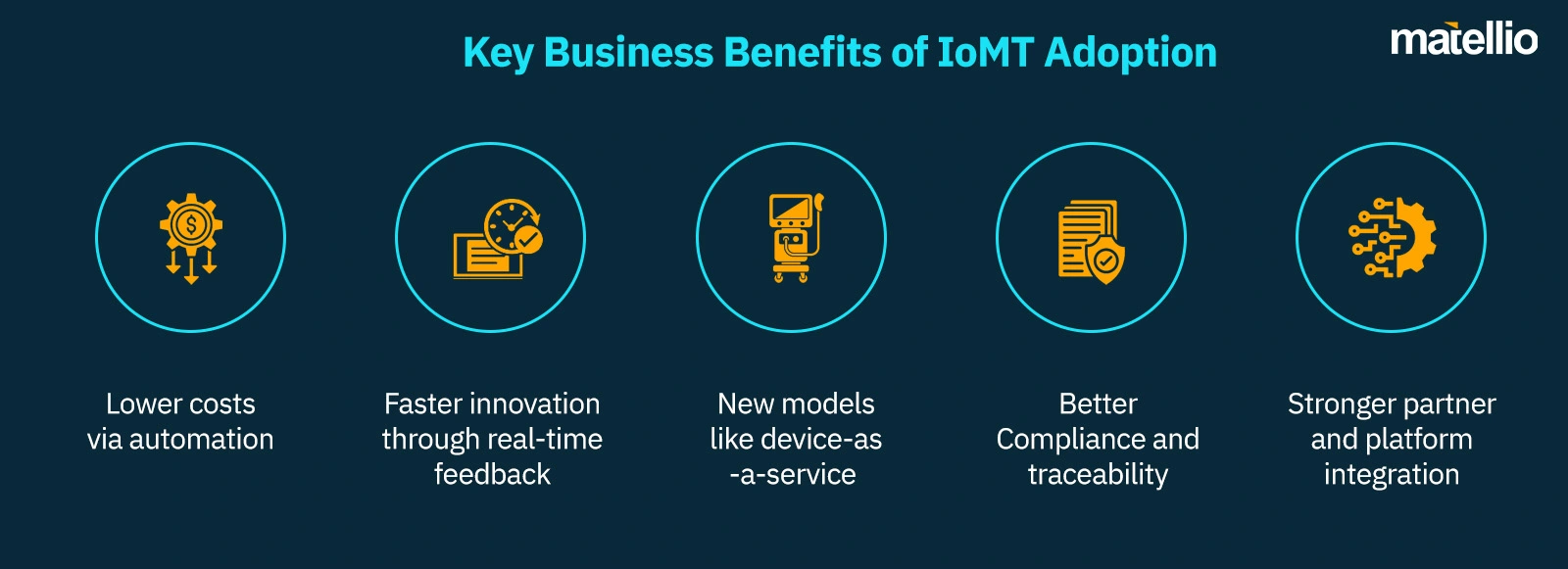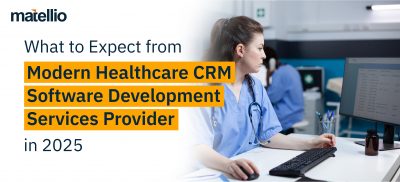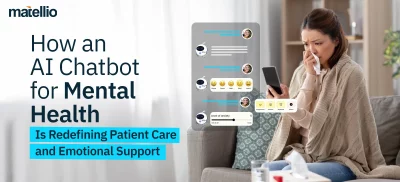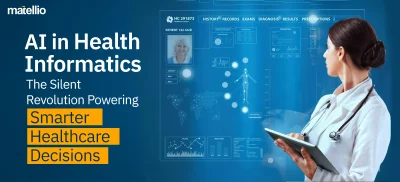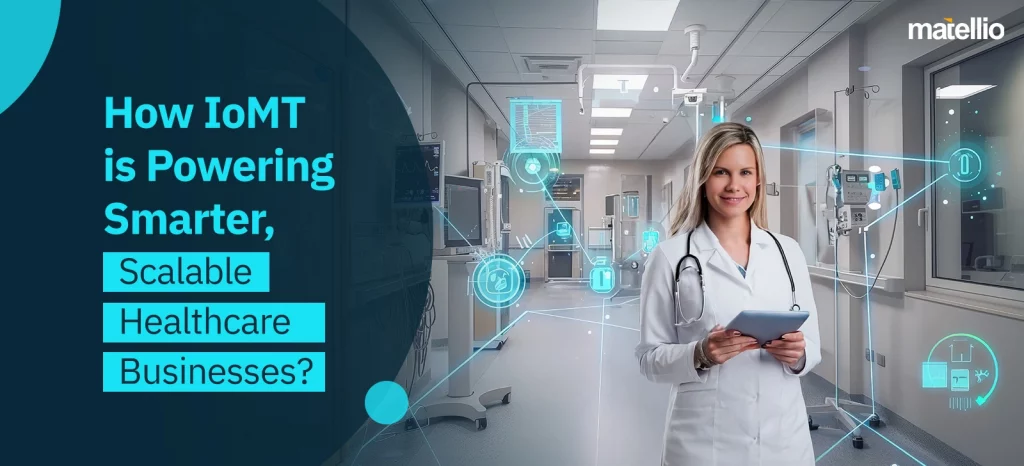
The future of healthcare is connected—and at the core of this transformation is the Internet of Medical Things. Unlike general IoT, which spans industries from logistics to retail, IoMT is purpose-built for healthcare—connecting medical devices, sensors, and software to streamline clinical and operational workflows.
But IoMT is more than just a clinical upgrade. For healthcare businesses, it’s a strategic growth engine. It drives smarter service delivery, real-time visibility, and entirely new revenue models. From remote monitoring to predictive diagnostics, IoMT enables both better care and better business.
This blog explores how IoMT helps healthcare-focused businesses scale faster, optimize resources, and stay competitive in a rapidly digitizing industry.
Let’s explore how smart connectivity becomes smart growth.
What is IoMT?
IoMT (Internet of Medical Things) refers to a network of connected medical devices, software applications, and health systems that communicate with each other over the Internet to collect, transmit, and analyze healthcare data in real-time.
Here’s a simple breakdown:
- “Internet” = Connectivity
- “Medical Things” = Devices like wearables, monitors, sensors, imaging machines, and even surgical tools
What Makes IoMT Different from General IoT?
While IoT spans across industries like manufacturing and retail, IoMT is built specifically for healthcare. It’s designed to support patient monitoring, diagnostics, treatment, and operational efficiency in clinical settings.
Strategic Use Cases of IoMT in Healthcare
The Internet of Medical Things (IoMT) is revolutionizing the way healthcare businesses operate, shifting care from isolated systems to deeply connected ecosystems. For healthcare-focused enterprises, IoMT unlocks more than better outcomes—it introduces new revenue models, operational efficiencies, and a path to sustainable digital growth. Here’s how different sectors within the healthcare industry are leveraging IoMT to innovate and scale:
Remote Patient Monitoring for Chronic Care Providers
Chronic care management is no longer tied to hospital visits. Using wearables and remote monitoring tools, businesses now enable continuous patient oversight from the comfort of home. This shift supports SaaS-based care delivery and personalized health plans. For companies offering IoMT Development Services, this creates an opportunity to build scalable, monetizable platforms that go beyond episodic treatment.
Smart Diagnostics for Lab Chains & Imaging Centers
Lab and imaging centers thrive on speed, accuracy, and uptime. With real-time diagnostics, predictive maintenance, and connected reporting, these organizations are transforming into data-driven hubs. This is where the Internet of Medical Things provides a crucial advantage—allowing diagnostics providers to accelerate service while reducing cost per test.
Connected Hospital Equipment for OEMs
Today’s medical OEMs are embedding sensors and connectivity into their devices to enable features like predictive maintenance and remote updates. By leveraging the Internet of Things and medical devices, manufacturers are moving from product-based to service-based models—offering hospitals uptime guarantees, analytics dashboards, and pay-per-use billing.
Post-Acute Care & Rehab Centers
Post-acute and rehab businesses are using wearable tech to monitor patient recovery, mobility, and treatment compliance beyond the facility. These systems provide dynamic feedback to care teams, reducing rehospitalization risks. One of the biggest benefits of IoMT here is the real-time adaptation of care plans, improving both efficiency and patient satisfaction.
Home Healthcare & Elder Care Solutions
Home-based care providers are rapidly adopting fall detection, medication tracking, and remote vital monitoring. With aging populations, the need for always-on, proactive care is rising. Internet of medical things companies are responding by developing smart devices and platforms that help care teams intervene before emergencies occur—improving trust and care quality.
Ambulatory & Multi-Site Facility Networks
Facilities operating across multiple sites need centralized visibility over assets, staff, and workflows. Connected devices allow live tracking, automated alerts, and resource optimization. With the Internet of Medical Things market projected to grow significantly, businesses offering multi-site coordination tools are positioned for exponential scale and partner expansion.
Medical Device Startups & API-Driven Platforms
New entrants in the health tech space are integrating Internet of Things medical applications into their platforms—enabling real-time insights, edge processing, and open APIs for integration with third-party EHRs and analytics systems. These startups are becoming vital components in the broader care ecosystem.
Ready To Turn Your Connected Care Platform into A Revenue Engine with IoMT?
IoMT Features Across Key Healthcare Sectors
The Internet of Medical Things (IoMT) offers targeted functionalities tailored to the needs of different healthcare segments. Below is a snapshot of how these features are applied across the ecosystem:
| Healthcare Sector | Key IoMT Features |
| Hospitals & ICUs | – Smart ICU beds with posture/movement detection
– Real-time vitals monitoring – Asset tracking for critical equipment |
| Home Healthcare | – Remote patient monitoring wearables
– Fall detection systems – Medication adherence tracking |
| Diagnostic Labs | – IoT-enabled sample tracking
– Equipment self-diagnostics – Automated quality control reports |
| Rehabilitation Centers | – Mobility tracking sensors
– Therapy compliance wearables – Cloud-based progress dashboards |
| Elder Care Facilities | – Emergency alert systems (panic buttons, wearables)
– Smart room sensors for safety – Vitals tracking synced with staff systems |
| Medical Device OEMs | – Predictive maintenance analytics
– Usage monitoring dashboards – Firmware updates via cloud |
| Pharmacies & Supply | – Cold chain monitoring for temperature-sensitive meds
– Inventory level alerts – Expiry and usage analytics |
| Telehealth Platforms | – Real-time streaming from connected devices
– Smart diagnostics integration – Remote exam tools (e.g., connected stethoscopes) |
Monetization Models Powered by IoMT Data
The Internet of Medical Things (IoMT) is not only transforming care—it’s also redefining how healthcare businesses generate revenue. From hardware manufacturers to digital health platforms, monetizing IoMT data opens up new, recurring income streams that are scalable, compliant, and future-focused.
Embedded Subscription Models for Device Insights and Analytics
Healthcare businesses are now bundling devices with subscription-based access to performance dashboards, compliance tools, and real-time analytics. This shift from product sales to device-as-a-service introduces stable, recurring revenue for device vendors and remote monitoring platforms.
We design and develop custom cloud-based IoT Healthcare Solutions that support real-time data collection, patient tracking, and multi-tier subscription access. Our experts build analytics modules that deliver value-added services—positioning your offering as a smart, revenue-generating ecosystem.
Data Monetization Through Research, Performance Tracking, and Digital Twin Modeling
The value of data doesn’t end with diagnostics. When anonymized and ethically managed, IoMT data becomes a goldmine for clinical research, AI modeling, and healthcare optimization. Businesses now sell access to insights for operational benchmarking, clinical trials, and digital twin simulations.
Our team enables secure data pipelines and analytics engines that allow you to monetize insights without compromising compliance. We specialize in building solutions that align with the broader Internet of Medical Things landscape—helping you convert data into a strategic business asset.
Integration of Smart APIs into Third-Party Platforms and EHRs
IoMT platforms are increasingly offering API access to third-party systems—EHRs, telehealth platforms, and billing apps—turning interoperability into revenue. Businesses can charge per API use, offer developer access tiers, or monetize through integration packages.
We build FHIR and HL7-compliant APIs for seamless integration between your platform and external healthcare systems. By enabling secure, scalable access, we help position your solution within the growing Internet of Things in medical infrastructure—ensuring long-term viability and revenue generation.
Performance Licensing for Device OEMs and Monitoring Services
OEMs are leveraging IoMT to provide remote diagnostics, firmware updates, and usage-based billing. With the rise of cloud-connected devices, licensing usage data to hospitals, insurance providers, or partner platforms adds an entirely new revenue stream.
We engineer cloud modules that support firmware updates, uptime tracking, and device performance insights. Our experts will help you transform your offering into a smart healthcare technology platform that generates value far beyond the point of sale.
Benchmarking & Predictive Care Insights for Large Healthcare Networks
Large hospital systems and diagnostic chains can sell anonymized benchmarking tools to partners or use predictive analytics to offer consulting-grade insights. This is especially impactful when built on the foundation of the medical Internet of Things and big data in healthcare.
Our AI-driven engines analyze aggregated patient and device data to produce predictive insights, benchmarking dashboards, and outcomes modeling. We help you commercialize intelligence—backed by a compliant and scalable framework.
Data-as-a-Service Platforms for Clinical Research & Pharma
Hospitals and device companies are building DaaS platforms, giving research organizations-controlled access to curated datasets. These services are now considered a major segment on the Internet of Medical Things market.
We design HIPAA-compliant data vaults, audit trails, and access controls. Our team helps healthcare businesses monetize insights responsibly, strengthening their brand among Internet of Medical Things companies and research networks.
Compliance-Driven Monetization in Regulated Markets
With increasing scrutiny on patient data, offering security-first platforms is now a monetization strategy in itself. Businesses can offer premium access tiers with advanced encryption, audit logging, and compliance tools—addressing growing concerns around the Internet of Medical Things cyber security.
We embed role-based access control, end-to-end encryption, and regulatory compliance frameworks into your system. Our solutions are purpose-built to support IoMT in healthcare, ensuring data integrity, audit readiness, and monetizable trust.
Service Expansion Through Interoperability and Analytics
Healthcare businesses that offer monitoring or diagnostic tools can expand into adjacent markets by enabling multi-system integration and analytics—supporting broader IoMT implementation strategies across healthcare networks.
From infrastructure to user experience, we help you build systems that scale—from standalone devices to enterprise-wide IoT healthcare solutions. Our experts ensure every layer of the platform supports revenue growth, operational flexibility, and patient-centric care.
Whether you’re a medical device manufacturer, healthtech startup, or diagnostics provider, monetizing IoMT data isn’t just possible—it’s essential. And with the right partner, it’s seamless.
How Matellio Helps Healthcare Businesses Build and Scale IoMT Solutions
At Matellio, we collaborate with healthcare organizations to turn connected technology into tangible business growth. From planning to deployment and beyond, we ensure your IoMT systems are secure, scalable, and built for real-world impact. Here’s how we help healthcare businesses launch and expand intelligently connected care.
- We begin by identifying your business needs, technical environment, and care delivery goals. Our team provides tailored IoT Consulting Services that cover use-case prioritization, device-to-cloud architecture, and regulatory guidance—ensuring your IoMT project starts with clarity and strategy.
- Whether you’re building a new device or expanding an existing product line, our teams develop custom firmware, cloud infrastructure, and user-facing platforms. Every solution is designed to align with the evolving landscape of the Internet of medical things, offering healthcare-grade reliability and innovation.
- Our integration specialists ensure your IoMT ecosystem connects seamlessly with existing platforms like EHRs, PACS, CRMs, and LIMS. With deep domain knowledge, we bridge the gap between the Internet of Things in medical devices and real-time clinical workflows, reducing complexity and maximizing value.
- Data security and privacy are critical in healthcare. Our architectures follow global protocols such as HIPAA, HL7, and GDPR, with layered protection strategies. We also address rising concerns around the Internet of Medical Things cyber security by embedding encryption, role-based access, and audit-ready design.
- From connected diagnostics to smart infusion pumps, we enable full integration of the Internet of Things and medical devices with business intelligence systems and cloud control panels—enhancing visibility, control, and responsiveness.
- Using telemetry from smart wearables, mobile health apps, and bedside monitors, we help you build solutions that drive real-world benefits of IoMT, such as preventive alerts, early diagnostics, and improved patient engagement across the care journey.
- We empower the Internet of Medical Things companies to scale with confidence by delivering modular platforms, reusable APIs, and ready-to-integrate analytics dashboards that accelerate time-to-market and foster product innovation.
Ready to build your connected care platform with confidence? Fill in the form to talk to Matellio’s experts and start your IoMT journey today.
